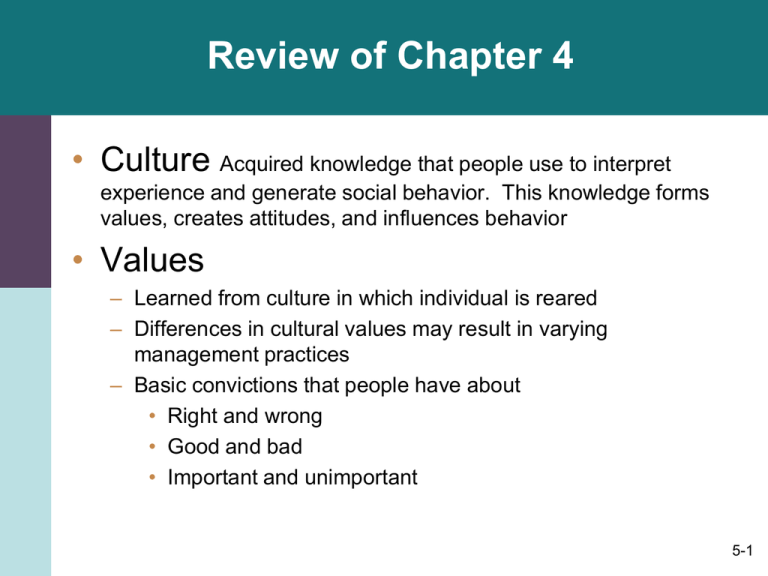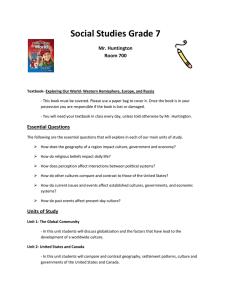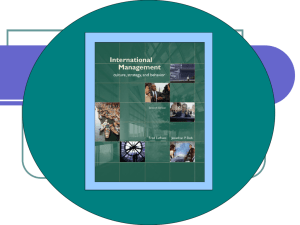
Review of Chapter 4
• Culture Acquired knowledge that people use to interpret
experience and generate social behavior. This knowledge forms
values, creates attitudes, and influences behavior
• Values
– Learned from culture in which individual is reared
– Differences in cultural values may result in varying
management practices
– Basic convictions that people have about
• Right and wrong
• Good and bad
• Important and unimportant
5-1
Hofstede’s Cultural Dimensions
1.
2.
3.
4.
Power distance
Uncertainty avoidance
Individualism/collectivism
Masculinity/femininity
5-2
Trompenaars’s Cultural dimensions
• Universalistic Vs. Particularistic
– Rules Vs. Relationships
– Legal System Vs. Personal System
– Contracts Vs. interpersonal trust
– Objectivity Vs. Relativity
– One Right way Vs. Many ways
5-3
Trompenaars’s Cultural dimensions
• Individualism Vs. Communitariansem
– Individual achievements Vs. Group
Reference
– Personal responsibility Vs. Shared
responsibility
– Standing out Vs. Fitting in
5-4
Trompenaars’s Cultural dimensions
• Neutral Vs. Emotional
– Physical contact reserved for close friends
and family Vs. more open and free
– Subtle communication Vs. Expressive Vocal
– Hard to Read Vs. Strong Body language
5-5
Trompenaars’s Cultural dimensions
• Specific Vs. Diffused
– Direct Vs. Indirect
– Confrontational Vs. Avoid direct
confrontation.
– Open: Extrovert Vs. More closed: Introvert
– Separate work and private life Vs. Link
private and work life
5-6
Cross-Cultural
Differences and Similarities
• Parochialism and Simplification
– Parochialism: view world through own eyes
and perspectives
– Simplification: exhibit same orientation
toward different cultural groups
5-7
chapter five
Managing Across Cultures
McGraw-Hill/Irwin
Copyright © 2009 by The McGraw-Hill Companies, Inc. All Rights Reserved.
Chapter Objectives
The specific objectives of this chapter are:
1. EXAMINE the strategic dispositions that
characterize responses to different cultures.
2. DISCUSS cross-cultural differences and
similarities.
3. REVIEW cultural differences in select
countries and regions, and note some of the
important strategic guidelines for doing
business in each.
5-9
Strategic Predispositions
Four distinct predispositions toward doing
things in a particular way:
1. Ethnocentric
2. Polycentric
3. Regio-centric
4. Geocentric
5-10
Strategic Predispositions
• Ethnocentric predisposition
– A nationalistic philosophy of management
whereby the values and interests of the
parent company guide strategic decisions.
5-11
Strategic Predispositions
• Polycentric predisposition
– A philosophy of management whereby strategic
decisions are tailored to suit the cultures of the
countries where the MNC operates.
5-12
Strategic Predispositions
• Regio-centric predisposition
– A philosophy of management whereby the firm
tries to blend its own interests with those of its
subsidiaries on a regional basis.
5-13
Strategic Predispositions
• Geocentric predisposition
– A philosophy of management whereby the
company tries to integrate a global systems
approach to decision making.
5-14
Orientation of an MNC
5-15
5-16
Meeting the Challenge
• The Globalization Imperative:
– Belief that one worldwide approach to doing
business is key to efficiency and effectiveness.
– Many factors facilitate the need to develop unique
strategies for different cultures
5-17
Many factors facilitate the need to develop unique
strategies for different cultures:
• The Globalization Imperative:
– Diversity of worldwide industry standards
– Continual demand by local customers for
differentiated products
– Importance of being insider as in case of
customer who prefers to “buy local”
– Difficulty of managing global organizations
– Need to allow subsidiaries to use own
abilities and talents unconstrained by
headquarters
5-18
Globalization vs.
National Responsiveness
• Advertising (for example)
– French
• Avoid reasoning or logic
• Advertising predominantly emotional, dramatic, symbolic
• Spots viewed as cultural events – art for sake of money –
and reviewed as if they were literatures or films
– British
• Value laughter above all else
• Typical broad, self-deprecating British commercial amuses
by mocking both advertiser and consumer
– Germans
• Want factual and rational advertising
• Typical German spot features standard family of 2 parents,
two children, and grandmother
5-19
Globalization vs.
National Responsiveness
• How to add value to marketing:
– you must be aware that your international
audience will frequently have different
tastes, needs and customs
– Tailor advertising message to particular
culture
– Stay abreast of local market conditions;
don’t assume all markets basically same
5-20
Globalization vs.
National Responsiveness
• How to add value to marketing:
– Your plan will need to address many other
factors, such as:
– payment (international transactions and currency
exchanges)
– paperwork (increased documentation),
– practices (different cultural, social and business
styles)
– partnerships (strategic alliances to strengthen
your market presence)
– protection (increased risks relating to payment,
intellectual property or travel)
5-21
Globalization vs.
National Responsiveness
• How to add value to marketing:
– Know strengths and weaknesses of MNC
subsidiaries; provide them assistance in
addressing local demands
– Give subsidiary more autonomy; let it
respond to changes in local demand
5-22
Cultural Variations
5-23
Cross-Cultural
Differences and Similarities
• Similarities across cultures:
– Not possible to do business same way in every
global location
– Procedures and strategies that work well at home
can’t be adopted overseas without modifications
– Some similarities have been found
• Russia and U.S. (for example)
–
–
–
–
–
Traditional management
Communication
Human resources
Networking activities
OB Mod
5-24
Cross-Cultural
Differences and Similarities
• Differences across cultures
– Far more differences than similarities found
in cross-cultural research
– Wages, compensation, pay equity,
maternity leave
– Importance of criteria used in evaluation of
employees
5-25
Cultural Clusters
5-26
International
Human Resource Management
5-27
Cultural Differences in Selected
Countries and Regions
Doing Business in China
1. The Chinese place values and principles above money and
expediency.
2. Business meetings typically start with pleasantries such as tea
and general conversation about the guest’s trip to the country,
local accommodations, and family.
3. The Chinese host will give the appropriate indication for when
a meeting is to begin and when the meeting is over.
4. Once the Chinese decide who and what is best, they tend to
stick with these decisions. Although slow in formulating a plan
of action, once they get started, they make fairly good
progress.
5-28
Cultural Differences in Selected
Countries and Regions: China
5. In negotiations, reciprocity is important. If the
Chinese give concessions, they expect some in
return.
6. Because negotiating can involve a loss of face, it
is common to find Chinese carrying out the whole
process through intermediaries.
7. During negotiations, it is important not to show
excessive emotion of any kind. Anger or
frustration is viewed as antisocial and unseemly.
8. Negotiations should be viewed with a long-term
perspective. Those who will do best are the ones
who realize they are investing in a long-term
relationship.
5-29
Cultural Differences in Selected
Countries and Regions
Doing Business in Russia
1.
2.
3.
4.
Build personal relationships with partners. When there
are contract disputes, there is little protection for the
aggrieved party because of the time and effort needed
to legally enforce the agreement.
Use local consultants. Because the rules of business
have changed so much in recent years, it pays to
have a local Russian consultant working with the
company.
Ethical behavior in the United States is not always the
same as in Russia. For example, it is traditional in
Russia to give gifts to those with whom one wants to
transact business.
Be patient. In order to get something done in Russia, it
often takes months of waiting.
5-30
Cultural Differences in Selected
Countries and Regions: Russia
5.
6.
7.
8.
Russians like exclusive arrangements and often
negotiate with just one firm at a time.
Russians like to do business face-to-face. So when
they receive letters or faxes, they often put them on
their desk but do not respond to them.
Keep financial information personal. Russians wait
until they know their partner well enough to feel
comfortable before sharing financial data.
Research the company. In dealing effectively with
Russian partners, it is helpful to get information about
this company, its management hierarchy, and how it
typically does business.
5-31
Cultural Differences in Selected
Countries and Regions: Russia
Stress mutual gain. The Western idea of “win–win” in
negotiations also works well in Russia.
10. Clarify terminology. The language of business is just
getting transplanted in Russia so double-check and
make sure that the other party clearly understands the
proposal, knows what is expected and when, and is
agreeable to the deal.
11. Be careful about compromising or settling things too
quickly because this is often seen as a sign of
weakness.
12. Russians view contracts as binding only if they
continue to be mutually beneficial, so continually show
them the benefits associated with sticking to the deal.
9.
5-32
Cultural Differences in Selected
Countries and Regions
• Doing business in India
1. It is important to be on time for meetings.
2. Personal questions should not be asked unless the
other individual is a friend or close associate.
3. Titles are important, so people who are doctors or
professors should be addressed accordingly.
4. Public displays of affection are considered to be
inappropriate, so one should refrain from
backslapping or touching others.
5-33
Cultural Differences in Selected
Countries and Regions: India
5. Beckoning is done with the palm turned down;
pointing often is done with the chin.
6. When eating or accepting things, use the right
hand because the left is considered to be unclean.
7. The namaste gesture can be used to greet people;
it also is used to convey other messages,
including a signal that one has had enough food.
8. Bargaining for goods and services is common;
this contrasts with Western traditions, where
bargaining might be considered rude or abrasive.
5-34
Cultural Differences in Selected
Countries and Regions
Doing business in France
1. When shaking hands with a French person, use
a quick shake with some pressure in the grip.
2. It is extremely important to be on time for
meetings and social occasions. Being
“fashionably late” is frowned on.
3. During a meal, it is acceptable to engage in
pleasant conversation, but personal questions
and the subject of money are never brought up.
4. Visiting businesspeople should try very hard to
be cultured and sophisticated.
5-35
Cultural Differences in Selected
Countries and Regions: France
5.
6.
7.
8.
The French tend to be suspicious of early friendliness
in the discussion and dislike first names, taking off
jackets, or disclosure of personal or family details.
In negotiations the French try to find out what all of the
other side’s aims and demands are at the beginning,
but they reveal their own hand only late in the
negotiations.
The French do not like being rushed into making a
decision, and they rarely make important decisions
inside the meeting.
The French tend to be very precise and logical in their
approach to things, and will often not make
concessions in negotiations unless their logic has
been defeated.
5-36
Cultural Differences in Selected
Countries and Regions
• Doing business in Arab countries
1. It is important never to display feelings of superiority,
because this makes the other party feel inferior. Let
one’s action speak for itself and not brag or put on a
show of self-importance.
2. One should not take credit for joint efforts. A great deal
of what is accomplished is a result of group work, and to
indicate that one accomplished something alone is a
mistake.
3. Much of what gets done is a result of going through
administrative channels in the country. It often is difficult
to sidestep a lot of this red tape, and efforts to do so can
be regarded as disrespect for legal and governmental
institutions.
5-37
Cultural Differences in Selected
Countries and Regions: Arab Countries
4.
5.
6.
Connections are extremely important in conducting
business.
Patience is critical to the success of business
transactions. This time consideration should be built
into all negotiations.
Important decisions usually are made in person, not
by correspondence or telephone. This is why an
MNC’s personal presence often is a prerequisite for
success in the Arab world. Additionally, while there
may be many people who provide input on the final
decision, the ultimate power rests with the person at
the top, and this individual will rely heavily on personal
impressions, trust, and rapport.
5-38
Review and Discuss
1. Define the four basic predispositions MNCs
have toward their international operations.
2. In what way are parochialism and
simplification barriers to effective crosscultural management? In each case, give an
example.
3. Many MNCs would like to do business
overseas in the same way that they do
business domestically. Do research findings
show that any approaches that work well in
the U.S. also work well in other cultures?
5-39
chapter six
Organizational Cultures
and Diversity
McGraw-Hill/Irwin
Copyright © 2009 by The McGraw-Hill Companies, Inc. All Rights Reserved.
Chapter Objectives
1.
2.
3.
4.
DEFINE what is meant by organizational culture;
discuss interaction of national and MNC culture
IDENTIFY four most common categories of
organizational culture and discuss characteristics of
each
PROVIDE overview of nature and degree of multiculturalism and diversity in today’s MNCs.
DISCUSS common guidelines and principles used in
building team and organizational multicultural
effectiveness.
5-41
The Nature of Organizational Culture
• Organizational culture: shared values and
beliefs enabling members to understand their
roles and the norms of the organization,
including:
– Observed behavioral regularities, typified by
common language, terminology, rituals
– Norms, reflected by things such as amount of work
to do and degree of cooperation between
management and employees
– Dominant values organization advocates and
expected participants to share (e.g., low
absenteeism, high efficiency)
5-42
Organizational Culture
(continued)
• Other values and beliefs:
– Philosophy set forth regarding how to treat
employees and customers
– Rules dictating do’s and don’ts of employee
behavior pertaining to productivity
intergroup cooperation…
– Organizational climate as reflected by way
participants interact with each other, treat
customers, and feel about how treated by
senior level management
5-43
Interaction between
National and Organizational Culture
• National cultural values of employees
may significantly impact their
organizational performance
• Cultural values employees bring to
workplace are not easily changed by
organization
5-44
Dimensions of Organizational Culture
5-45
European Perceptions of Cultural
Dimensions of U.S. Operations
(same MNC)
5-46
European Management
Characteristics
5-47
Organizational Cultures in MNCs
• Shaped by numerous factors including
cultural preferences of leaders and
employees
• Some MNCs have subsidiaries that
(aside from logo and reporting
procedures) wouldn’t be easily
recognizable as belonging to same MNC
5-48
Organizational Culture in MNCs
•
Four steps in integration of organizational
cultures resulting from international
expansion via mergers/acquisitions:
1. Two groups establish purpose, goals, and focus
of merger
2. Develop mechanisms to identify most important
structures and manager roles
3. Determine who has authority over resources
4. Identify expectations of all involved participates
and facilitate communication between
departments and individuals
5-49
Four Cultural Types
5-50
Four Cultural Types
1. Family Culture: Strong emphasis on
hierarchy and orientation to persons
Power oriented, headed by leader regarded
as caring parent
Management takes care of employees,
ensures they’re treated well, and have
continued employment
Catalyze and multiply energies of personnel
or end up supporting leader who is
ineffective and drains energy and loyalties
5-51
Four Cultural Types
2. Eiffel Tower:
Strong emphasis on hierarchy and
orientation to task
Jobs well defined; coordination from top
Culture narrow at top; broad at base
Relationships specific and status remains
with job
Few off-the-job relationships between
manager and employee
Formal hierarchy is impersonal and efficient
5-52
Four Cultural Types
3. Guided Missile:
Strong emphasis on equality in workplace
and in task
Culture oriented to work
Work undertaken by teams or project
groups
All team members equal
Treat each other with respect
Egalitarian and task-driven organizational
culture
5-53
Four Cultural Types
4. Incubator Culture:
Strong emphasis on equality and personal
orientation
Organization as incubator for selfexpression and self-fulfillment
Little formal structure
Participants confirm, criticize, develop, find
resources for, or help complete
development of innovative product or
service
5-54
National Patterns
of Corporate Culture
5-55
Managing Multiculturalism and
Diversity
• Both domestically and internationally,
organizations lead workforces with a
variety of cultures consisting of largely
diverse populations:
– Women and Men
– Young and Old
– Black, White, Latin, Asian, Arab, Indian
– Many others.
5-56
Phases of Multicultural Development
5-57
Locations of Cross-Cultural
Interaction
5-58
Types of Multiculturalism
• Domestic Multiculturalism
– Multicultural and diverse workforce
operating in MNC home country
– Group Multiculturalism
• Homogenous groups
• Token groups
• Bicultural groups
• Multicultural groups
5-59
Potential Problems
Associated with Diversity
• Perceptual problems
– When cultural diverse groups come together, often
bring preconceived, erroneous stereotypes with
them
• Inaccurate biases
• Inaccurate communication
• Attitudinal problems
– May cause lack of cohesion resulting in unit’s
inability to take concerted action or be productive
5-60
Advantages of Diversity
•
•
•
•
•
Enhance creativity
Lead to better decisions
More effective/productive results
Prevent groupthink
Can facilitate highly effective teams
under right conditions
5-61
Managing Multicultural Teams
• Select team members for task-related abilities,
not solely based on ethnicity
• Team members must recognize and prepare
to deal with their differences
• Team leader must help identify/define overall
goal
• Mutual respect among members is critical
• Managers must give team positive feedback
on process and output
5-62
Review and Discuss
1. In which of the four types of organizational
cultures – family, Eiffel Tower, guided missile,
incubator – would most people in U.S. feel
comfortable?
2. Most MNCs need not enter foreign markets
to face challenges of dealing with
multiculturalism. Do you agree or disagree?
3. What are some problems to be overcome
when using multiculturally diverse teams?
4. What are some basic guidelines for helping
make diverse teams more effective?
5-63







